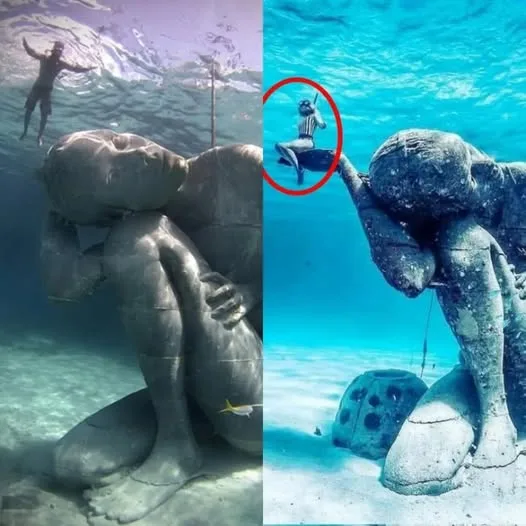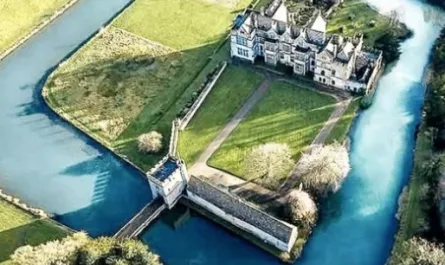Nestled beneath the turquoise waves off the western coastline of New Providence in Nassau, Bahamas, lies a breathtaking marvel that blends art, nature, and conservation: Ocean Atlas, the largest underwater sculpture in the world. Created by renowned artist Jason deCaires Taylor and installed in 2014, this awe-inspiring work of art is more than just a visual spectacle—it’s a powerful statement about humanity’s relationship with the ocean and a beacon for marine conservation. Let’s dive into the story, significance, and allure of Ocean Atlas, a must-see for adventurers, art enthusiasts, and environmentalists alike.

The Vision Behind Ocean Atlas
Ocean Atlas stands at an impressive 18 feet (5 meters) tall and weighs approximately 60 tons, making it a colossal presence on the seabed. Crafted from pH-neutral marine cement, the sculpture was designed to withstand the test of time, with an estimated lifespan of centuries. The figure depicts a young Bahamian girl, modeled after a local student named Camilla, kneeling on the ocean floor as if bearing the weight of the sea above her. This imagery draws inspiration from the Greek Titan Atlas, who was condemned to carry the heavens on his shoulders for eternity. In this modern interpretation, the girl symbolizes future generations tasked with the monumental responsibility of protecting our oceans from threats like overfishing, habitat destruction, ocean acidification, global warming, and pollution.
The sculpture was commissioned by the Bahamas Reef Environment Educational Foundation (BREEF) as part of the Sir Nicholas Nuttall Coral Reef Sculpture Garden, a project aimed at promoting marine conservation and sustainable tourism. By placing Ocean Atlas in the shallow waters of the Clifton Heritage National Park, the initiative not only showcases art but also serves a practical purpose: creating an artificial reef to support marine biodiversity.
A Fusion of Art and Ecology
What makes Ocean Atlas truly remarkable is its role as an artificial reef. The sculpture’s textured surface is specifically engineered to encourage coral polyps to attach and grow, providing a foundation for new coral colonies. Over time, this fosters a thriving ecosystem, attracting fish, crustaceans, and other marine life. By drawing divers and snorkelers to this man-made site, Ocean Atlas helps alleviate pressure on natural coral reefs, which are often overburdened by tourism and vulnerable to damage.
The choice of materials is critical to its ecological function. The pH-neutral marine cement ensures that the sculpture integrates harmlessly into the marine environment, avoiding any chemical interference with the delicate balance of the ecosystem. A solar-powered light and flag at the sculpture’s apex serve as a navigational aid for boats, further embedding Ocean Atlas into the practical and cultural fabric of the area.
The creation of Ocean Atlas was no small feat. Due to its massive scale, the sculpture was assembled underwater in sections, a pioneering technique developed by Taylor to overcome logistical challenges. This process underscores the ambition and innovation behind the project, blending engineering, artistry, and environmental science.
A Symbol of Local and Global Significance
Beyond its ecological contributions, Ocean Atlas carries deep cultural and symbolic weight. By featuring a Bahamian girl as the central figure, the sculpture celebrates local identity while addressing universal themes of environmental stewardship. Its location near a site once polluted by an oil leak from a power station adds another layer of meaning, highlighting the Bahamas’ ongoing efforts to combat marine pollution and restore their waters.
Ocean Atlas is part of a broader underwater art installation within the Clifton Heritage National Park, which also features works by Bahamian artists. Willicey Tynes’ Virtuoso Man and Andret John’s Lucayan Face join Ocean Atlas in this submerged gallery, alongside BREEF’s artificial reef balls. Together, these installations create a unique underwater museum that invites visitors to reflect on the intersection of art, culture, and nature.
Visiting Ocean Atlas: A Diver’s Dream
For those eager to experience Ocean Atlas firsthand, the sculpture is accessible to both snorkelers and scuba divers at a depth of approximately 16 feet (5 meters). Located in the warm, clear waters of Nassau, it’s an ideal destination for adventurers of all skill levels. The Clifton Heritage National Park offers snorkeling and diving tours, with equipment readily available for rent. The shallow depth ensures that even novice snorkelers can enjoy a close-up view of the sculpture, while divers can explore the surrounding marine life that has begun to colonize the structure.
The experience of encountering Ocean Atlas underwater is nothing short of magical. The interplay of light filtering through the water, the gentle sway of sea plants, and the presence of colorful fish darting around the sculpture create a surreal, almost otherworldly atmosphere. It’s a moment that combines the thrill of exploration with a profound appreciation for the fragility of marine ecosystems.
Why Ocean Atlas Matters
Ocean Atlas is more than just a record-breaking sculpture; it’s a call to action. By merging art with environmental advocacy, Jason deCaires Taylor and BREEF have created a powerful platform to raise awareness about the challenges facing our oceans. The sculpture serves as a reminder that human creativity can coexist with nature, fostering solutions that benefit both ecosystems and communities.
For visitors to the Bahamas, Ocean Atlas offers a unique opportunity to engage with art in a way that’s immersive, meaningful, and unforgettable. Whether you’re a diver, a snorkeler, or simply someone passionate about conservation, this underwater masterpiece invites you to witness the beauty of the ocean and reflect on our collective responsibility to protect it.
Plan Your Visit
Ready to dive in? Head to the Clifton Heritage National Park in Nassau, where Ocean Atlas awaits. Local tour operators offer guided snorkeling and diving excursions, and the park provides all the necessary equipment. Be sure to check weather conditions and tide schedules for the best visibility, and consider supporting BREEF’s conservation efforts through donations or volunteer opportunities.
In a world where our oceans face unprecedented challenges, Ocean Atlas stands as a testament to the power of art to inspire change. So grab your snorkel, dive into the crystal waters of the Bahamas, and discover the largest underwater sculpture in the world—a monument to resilience, beauty, and hope.





